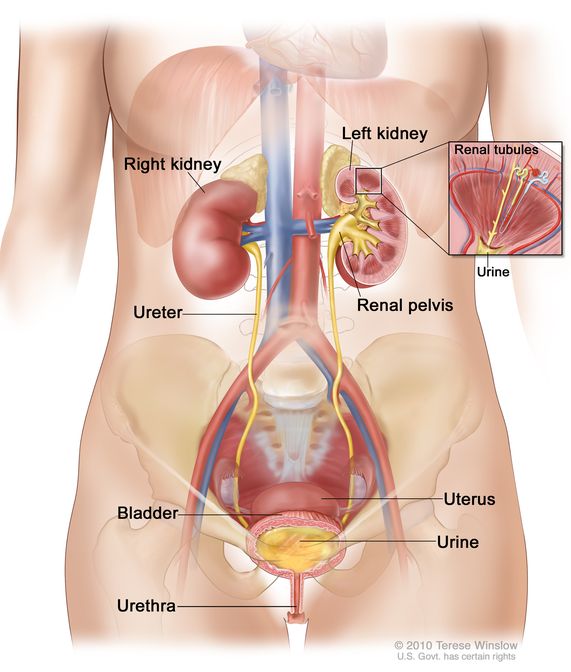The Kidneys Study Guide
Introduction
The urinary system is responsible for eliminating the waste from the body generated during the cellular metabolic process. It also regulates the water-electrolyte balance to maintain homeostasis. The kidneys are the urinary system’s main organ, containing nephrons that filter blood to produce urine.
The Human Kidney
The anatomy of the kidney is quite complicated for a small organ that measures about 10cm in length, and 7cm in width! This kidney diagram shows the structure of the organ:
Kidney Structure
- The kidney is bean-shaped with a convex outside surface and a concave inner surface.
- It can be divided into 3 regions.
- The innermost region is called the renal pelvis, part of the hilum, where blood vessels and nerves enter and leave the organ.
- The middle region is called the medulla.
- The last region is called the outer cortex.
- The renal cortex consists of filtration structures called nephrons.
- The medulla comprises 8 pyramidal structures called renal pyramids, with their tips pointing towards the renal pelvis. The spaces between the renal pyramids are called renal columns.
- The kidney location is below the rib cage in the back of the abdomen on either side of the vertebral column. The kidney location in the human body is as shown by the image below:
Urine formation in the kidneys
The nephrons are the functional unit responsible for the production of urine. This diagram shows the location and structure of the nephrons.
The kidney function in urine production is as follows:
- The blood to the kidneys is supplied by the renal arteries, which branch into capillaries in the glomerulus of the nephron. The pressure forces the water and dissolved substances into the bowman’s capsule.
- The filtered substances make their way to the renal tube, which is selectively reabsorbed into the blood.
- The fluid continues into a collecting duct where some water is reabsorbed and returned to the bloodstream. The waste urine is left behind in the collecting duct.
Conclusion
- The kidneys are the main organs of the urinary system.
- They contain a complicated network of millions of nephrons that filter blood to produce urine.
FAQs
1. What do the kidneys do?
The kidney in the human body filters the blood to remove metabolic waste and toxins. It also maintains the water-electrolyte balance in the body.
2. What are the first signs of kidney problems?
- Tiredness and having less energy
- The need to urinate more often
- Sleep disturbances and trouble concentrating
- Change in the color of urine to blood-red/ foamy urine
- Swollen ankles and feet
3. What are the 7 functions of the kidney?
- Controlling water balance in the body
- Controlling electrolyte balance in the body
- Regulating acid-base concentrations in the body
- Removing metabolic waste and toxins from the body
- Regulating blood pressure
- Activating vitamin D
- Secretion of the hormone Erythropoietin
4. Why do kidneys fail?
Kidneys can fail suddenly because of damage from a physical injury. Usually, kidney damage and failure take many years and are caused by diabetes and high blood pressure conditions.
5. What color is urine when your kidneys are failing?
The normal color of urine is light to dark yellow. Under certain medications, it can also become orange or blue. When a normal person has red or dark brown color urine, it could signify kidney failure.
6. Why does it hurt where my kidney is?
Several reasons from back pain to kidney stones, infection, urinary tract infection, or kidney injury.
7. Why do we have 2 kidneys?
Kidneys are vital organs needed for the survival of an organism. If one kidney fails because of an injury or infection, the body can continue to function on the remaining kidney.
8. How do I keep my kidneys healthy?
- Maintain good health
- Drink plenty of water
- Control blood sugar
- Keep high blood pressure under check
- Quit smoking
- Avoid taking high-risk OTC medicines
9. Can you live without kidneys?
It is possible to live with just one kidney. However, dialysis can extend lifespan or compensate for the waiting period to get a new kidney in the absence of kidneys.
We hope you enjoyed studying this lesson and learned something cool about the Kidneys! Join our Discord community to get any questions you may have answered and to engage with other students just like you! Don’t forget to download our App to experience our fun VR classrooms – we promise, it makes studying much more fun 😎
Sources:
- 10 Signs You May Have Kidney Disease. https://www.kidney.org/news/ekidney/august14/10_Signs_You_May_Have_Kidney_Disease. Accessed on 26 Nov, 2021.
- What is Kidney Failure?. https://www.kidney.org/atoz/content/KidneyFailure#:~:text=Kidneys%20can%20become%20damaged%20from,gradual%20loss%20of%20kidney%20function. Accessed on 26 Nov, 2021.
- Kidney Health and Kidney Disease Basics. https://www.healthline.com/health/kidney-disease#symptoms. Accessed on 27 Nov, 2021.
- Kidneys. https://flexbooks.ck12.org/cbook/ck-12-biology-flexbook-2.0/section/13.43/primary/lesson/kidneys-bio/. Accessed on 26 Nov, 2021.
- What Happens When One Or Both Kidneys Are Removed?. https://www.scienceabc.com/humans/can-you-live-without-kidneys.html. Accessed on 27 Nov, 2021.
- Human excretory system. https://physicscatalyst.com/biology/human-excretory-system.php. Accessed on 27 Nov, 2021.


